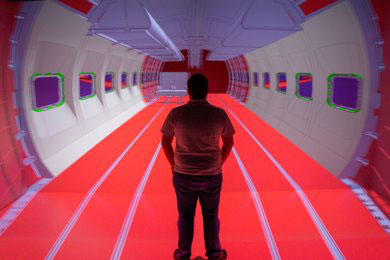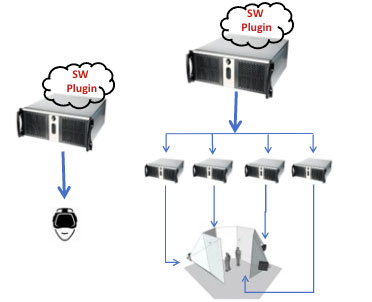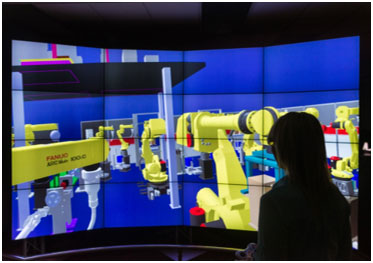Unsure how to get your data into an immersive virtual reality environment? Here are three options.
Virtual Reality (VR) can radically advance innovation and understanding, but like every visual display technology solution, it’s only as valuable as the content it communicates. You can buy the biggest, most incredible television, but if you use an antenna to get content, you’ll never realize the full value of your investment.
Content is often a stumbling block for prospective adopters of VR technology. It’s one thing to migrate files from a desktop PC to a laptop, but converting 3D data from a monoscopic desktop monitor to stereoscopic 3D data with virtual reality capabilities can be a daunting proposition even for those who’ve already invested in VR systems and want to increase utilization.
Maybe you’ve asked yourself, How do I create data for VR? How do I transfer data? Can I display non-VR data in VR environments and, if so, how hard is it?
Mechdyne team members field questions on this topic almost every time we present on immersive, augmented and virtual reality. It’s of particular concern for those charged with making a business case for investing in VR.
Here are the three most common ways to get your data into a virtual reality environment:
Native VR Capability
 With the increasing prevalence of head mounted VR devices (HMDs) more and more applications are offering native VR capability – including ones that you may use all the time without realizing it.
With the increasing prevalence of head mounted VR devices (HMDs) more and more applications are offering native VR capability – including ones that you may use all the time without realizing it.
If you already have a 3D-capable software, or are choosing among 3D options, look for native VR capability. You might find a button or menu choice that allows for data to display in 3D stereo.
Some programs, like Revit, will work directly in VR for viewing with head-mounted displays (HMDs). Other programs, like Autodesk VRED, Dassault 3D Experience or Siemens Teamcenter, will display in everything from an HMD to a CAVE. You simply choose the display you want to output to, and off you go.
It’s all programmed into the application.
But if you’re not using VR currently, you might not know anything about that. It’s important, then, to familiarize yourself with the apps that have native VR capability, especially when researching a software purchase. You may not use VR now, but If there’s a chance you’ll do so later, why not choose the app that enables easy data transfer to VR?
One thing to note: Most of these VR capable programs will have their limitations. Some are limited to HMD and won’t work in large-scale immersive virtual reality environments. Some are suitable only for viewing and won’t allow you to manipulate the image or send changes back to your workstation. The data flows in just one direction.
Data Interception to VR
The better name for this method is “interception of 3D geometry for VR enablement.” What that means is this: You install a plug-in on your computer – for example, Techviz. The graphics card in your computer is already calculating and creating the geometry of a 3D object. The interceptor will use that geometric representation for your VR device or environment. 
Let’s say you have a complex factory model whose 3D geometry is in CAD and viewable only in monoscopic/2D mode. The interceptor looks at all those geometric points, calculates the left eye/right eye viewpoints that are necessary for 3D stereo viewing, and basically redraws the object as a VR-capable model within that application.
You’ll have 3D viewing with no data loss because the true geometry is being used. But – and this is key – you won’t have the actual data. You’ll have a redrawn facsimile of it; a representation of the original model. The interceptor plug-in will also include motion tracking and navigation capabilities for interaction with the model.
However, You might not have bidirectional capabilities. You can load your 3D model and view it on an HMD or in a CAVE. You can turn it and spin it, but you may not be able to change the virtual model and have the changes automatically reimport it to your desktop.
It’s important to note that the technology is evolving rapidly. Some interceptors have developed limited manipulation functionality for specific applications.
For example, you may be able to take measurements of the virtual model. It might be able to recognize components of the model and allow you to grab and manipulate them individually. The degree of interaction is typically programmed into the viewer.
Beyond bi-directionality, there’s also the issue of viewing limitations. Some interceptor applications work only with HMDs. Techviz has additional display compatibility, like Mechdyne’s getReal3D for Unity, taking immersive viewing to the next level by absorbing not just the geometry of your model, but also the scale and type of display to enable viewing in advanced immersive displays like a CAVE.
An HMD offers just a single viewing plane. A typical CAVE, on the other hand, has four screens, so the plug-in has to separate the model into multiple, distinct viewpoints, or “frustums.” The math here gets very complicated, and not all VR-enabling software can handle it.
Game Engines With VR Support
If you’re doing CAD work or other modeling, it may seem odd to use a game engine for conversion or creation of new VR content. But game engines have done a fantastic job of making it possible to import other apps into their engines, and deliver a custom interactive experience.
Due to the nature of the gaming universe, where a premium is placed on photorealism and user interaction, the engines can absorb huge amounts of data beyond 3D geometry, including color, hierarchy, and metadata. Moreover, they enable extensive customization, allowing you to add photorealism, characters and behaviors, as well as physical properties that make the user experience significantly more engaging.
Imagine a car company that wants to create a presentation of a new vehicle. They may take a CAD model, import it into Unreal or Unity and place the product in a showroom environment. Taking advantage of game engine properties, they can populate that showroom with characters. They can add physics to the scene, so that car doors will close when a character bumps into them.
The possibilities are vast. Displaying the data can be done natively into an HMD. Also using native capability or a VR-enabling plug-in, like getReal3D, these enhanced models can be viewed in CAVEs and other immersive, interactive environments.
The importance of understanding your options
If “How do we get our data into VR?” is the most common question we get during presentations, “Which method of data transfer to you recommend?” is a close runner-up. But there’s no easy answer to that question. Before we can even venture a suggestion, we have to ask a question of our own: “What are your use cases?”
If your primary use of VR is for design review, an interceptor may fit the bill. If you’re using VR for major presentations to clients, investors or the media, you may want to go with a game engine, which will enable a more photorealistic, interactive presentation.
Of course, that raises additional questions. Do you have anyone in your organization with the skills to create or work within a game engine? How frequently will you use the technology – frequently enough to hire someone? Or are you project-based, where third-party assistance can provide content generation? (Which Mechdyne also provides).
Remember, too, that it’s possible to view VR in more than just head-mounted displays. We’ve blogged before about the value of looking beyond HMDs. Your use cases may be evolving to the point that you want to make the transition to larger scale immersive VR environments like CAVEs or video walls, in which case you’ll need to look at data creation and transfer in a new light.
The good news here is that the solution you need is undoubtedly out there. And the way VR technology is proliferating, your available options will only increase.
We can help you sort through the choices
Mechdyne has been creating VR solutions for more than a quarter century. We actually invented some of the tools that have become industry standards (like getReal3D for Unity). Regardless of whether you’ve already embraced virtual reality or are still mulling it over, we can provide an unbiased assessment of what makes sense for your use cases.
Maybe you already know that VR technology makes sense for your organization, but aren’t quite sure how to make the case to those who hold the purse strings. Whether you need to convince your CEO or a grant-bestowing institution, we can help.
Every day, we explore these issues with clients – reviewing their use cases, surveying available technologies, and compiling the information necessary to build a business case. There’s a universe of possibilities out there, and at the very least, we can help expand you’re understanding of which ones will best advance your strategic objectives.
And by all means, if you have any questions about getting your data into VR, we’re eager to share everything we know.


